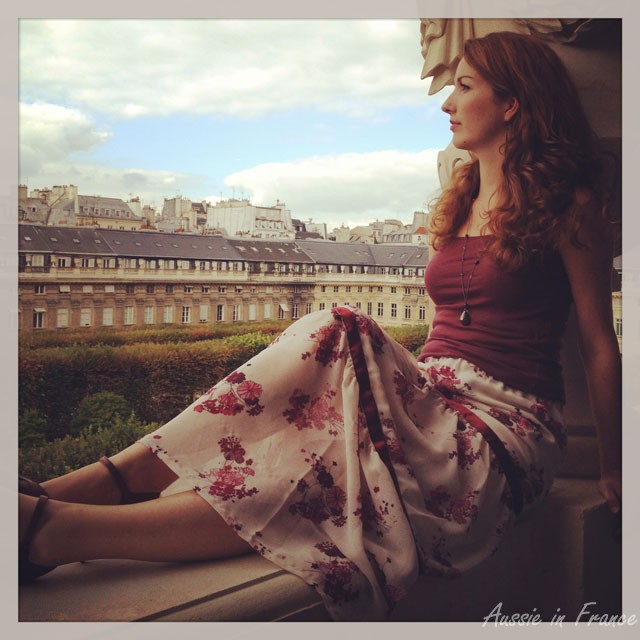This week I spent a most enjoyable day shooting photos of my daughter, Black Cat, for her new sewing blog: New York Paris Needle. This is our favourite photo taken from our balcony in the Palais Royal!
All posts by Rosemary Kneipp
Friday’s French – s’embrouiller
Well, when I left some homework at the end of last week’s post about “confusing”, I didn’t realise it was so difficult. My apologies.
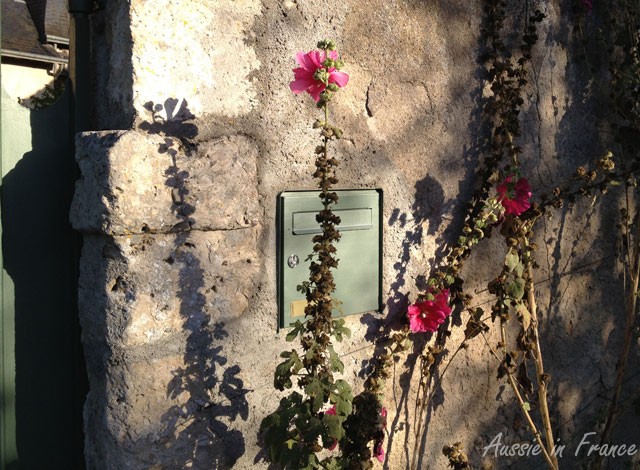
Two brave souls did, however, take up the challenge. Both found a good solution for the third sentence i.e.
3) Imminent and eminent are easily confused words.
Il est très facile de confondre les mots imminent et éminent.
On confond facilement le mot imminent avec éminent.
But the other two sentences caused a lot of confusion to say the least.
1) Are you still confused about how to use confuse in French?
2) I was confused when nothing happened.
Now, I asked a couple of Frenchies for help and the best we seem to have come up with are the following:
1) Avez-vous toujours du mal à savoir utiliser le verbe “to confuse” en français?
2) J’étais étonné qu’il ne se soit rien passé.
If nothing, it proves that “confusing” can rarely be translated literally.
Both my contributors attempted to use the verb s’embrouiller and I realised that my explications musn’t have been very clear.
The past participle “embrouillé” cannot apply to a person. You can have “une histoire embrouillée”, “des idées embrouillées”, “les paroles embrouillées”, but neither you nor anyone else can be “embrouillé”.
If you want to say you got confused about something or muddled up, you have to use the reflexive verb: je me suis embrouillée en voulant suivre ses explications – I got confused trying to follow his explanations. Il s’est embrouillé dans ses réponses. He got his answers muddled up. It’s all confused in my mind.
François Hollande s’est embrouillé sur la baisse de la TVA pendant de son discours: François Hollande got confused about the drop in VAT/GST during his speech.
Another slightly different meaning can be seen in the following sentence: Autour de vous, tout s’embrouille, les images deviennent floues ou semblent irréelles. All around you, there is confusion, the images became fuzzy or seemed unreal. Tout s’embrouille dans ma mémoire. It’s all mixed up in my memory.
Sometimes people confuse s’embrouiller et se brouiller which can mean to have an argument: je me suis brouillé hier avec ma copine: my girlfriend and I had a fight yesterday.
It can, however, be used to mean “confuse”: tout se brouilla dans sa tête: everything became confused or muddled in his mind. And guess how you say “scrambled eggs” in French? Oeufs brouillés!
All very confusing, isn’t it?
A Vide-grenier from the inside
It’s not the first time Black Cat and I have participated in a vide-grenier. Living in an appartment with no cellar meant we needed to regularly get rid of toys and clothes and the local town hall had a free garage sale for kids once a year. After that, we shared stalls with friends until Black Cat was old enough to branch out on her own.
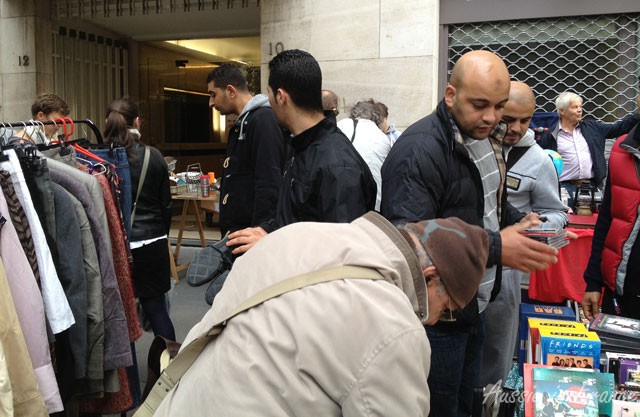
With our move to Blois scheduled for 30 September 2014 and Black Cat actively looking for work in New York, we have taken a stall at the yearly vide-grenier in nearby Rue Colonel Driant. We’re up early and at 8.15 am we’re handing in our documents (ID and electricity bill to prove we are locals) and paying 15 euro in exchange for 2 metres of pavement space. I go and get the car which Jean Michel has filled up the day before and park it temporarily in front of stand n°65 while we unload.
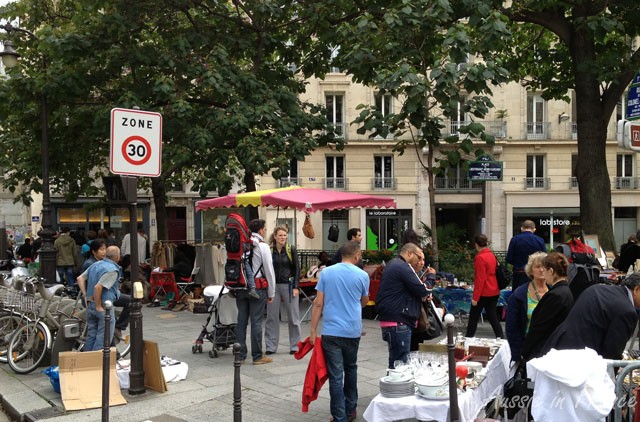
We set up a trestle table and Black Cat starts putting the clothes rack together. As we unpack, the early scavengers arrive, mainly looking for jewellery. By the time we have everything out of the cartons, it’s 9 am and we’ve already made a couple of sales. We also make the acquaintance of our neighbours.
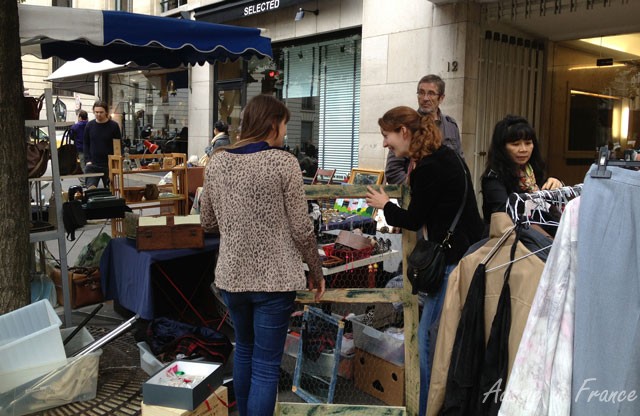
On the left is a Ukranian girl and her French friend. It’s their first vide-grenier but, apart from the fact that their two clothes racks topple over at regular intervals, they seem to have their act together. They have a mirror which we don’t have but they lend it to us whenever we need one. They seem to be having a whale of a time. Everytime I look over they seem to be dressed differently!
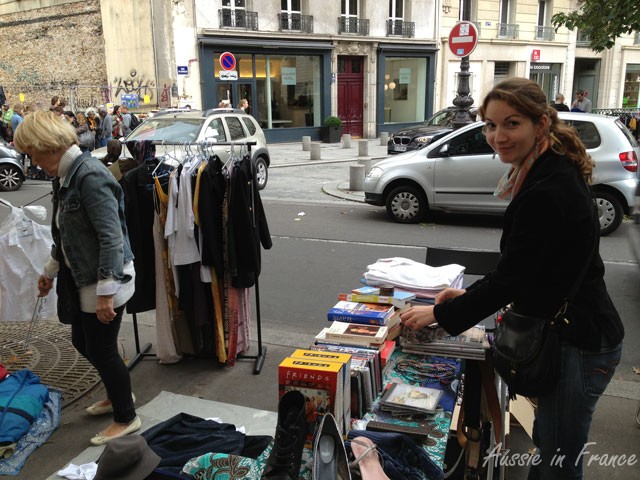
The lady on the left is a regular. She has a small stock of women’s clothes that she has brought in a suitcase, including a rack that regularly falls over with the wind as well. She also has two plastic sheets that she spreads on the ground to display anoraks and jackets. She explains later in the day that she buys summer dresses cheaply on cheaper markets and sells them on the more expensive ones.
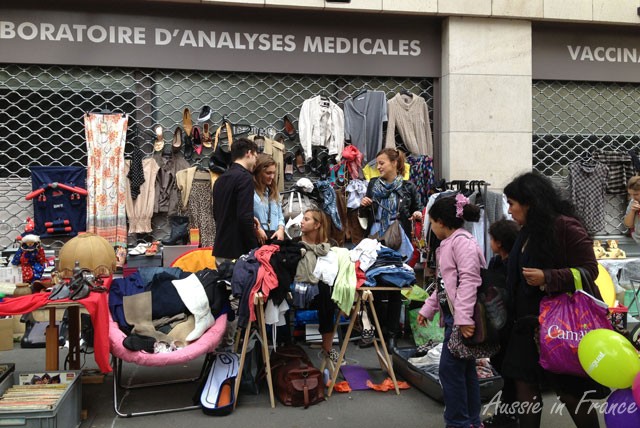
I’ve brought along two folding chairs because I know I can’t stand up all day. We can’t possibly display everything we have on the clothes rack and table so we work out a new arrangement. We put the table on one side and the rack on the other so that people can enter the stand and also look through our cartons which we’ve divided into tops, skirts, dresses and pants.
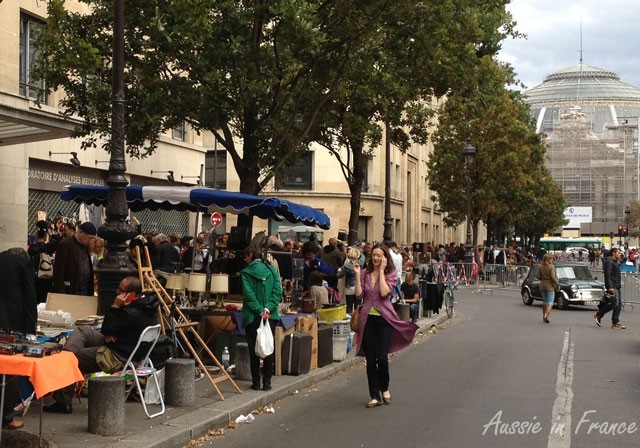
Business is steady. Black Cat’s fairly large collection of DVDs, a handful of CDs and my books are the most popular initially. At 2 euro for a DVD and 1 euro for a book, you’d think it was a bargain but there are still people who want to bring the price down. We’re selling the clothes at 2 euro for a top or skirt, 3 euro for a dress and 5 to 10 euro for jackets and coats.
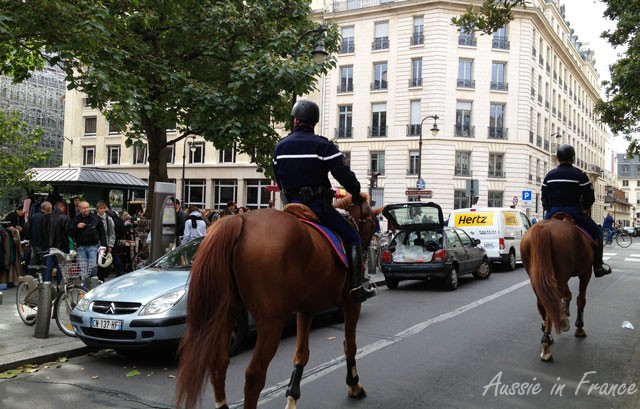
Late morning, I go back home and make a large thermos of tea which I bring back and share with our neighbours who are delighted. “Oh, but I don’t have anything to offer you”, says the Ukrainian. “That’s OK. We’re using your mirror.” But when I bring the second thermos around 4 pm, she has acquired some biscuits to share.
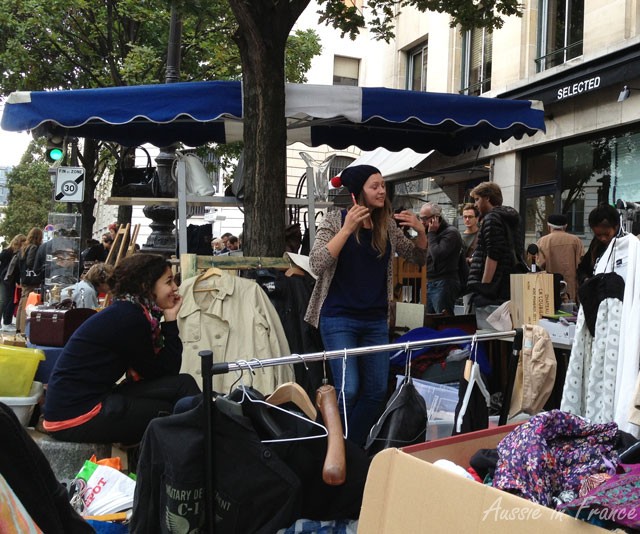
During the day, at least three English speakers, hearing me chatting with Black Cat, come up and ask for directions!
Most of the people are friendly which is not true of all street markets. I tell someone that Black Cat has made some of the clothes herself. Those items are snapped up as unique pieces. One young woman makes us laugh as she wiggles into a skirt then removes her own from underneath so she can check if it fits properly.

There’s a big fight at the stall opposite at one stage when a woman claims that she hasn’t had her money’s worth. It looks as though they might come to blows but she finally walks away.
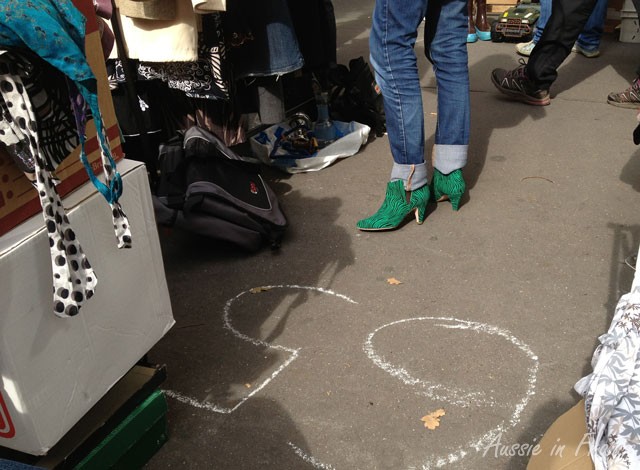
At about 6 pm, business picks up and we bring the prices down even further. I tell my neighbours they can take what they want because they are all doing another vide-grenier next day. Then it starts to spit and we all have to start packing up before everything gets wet.
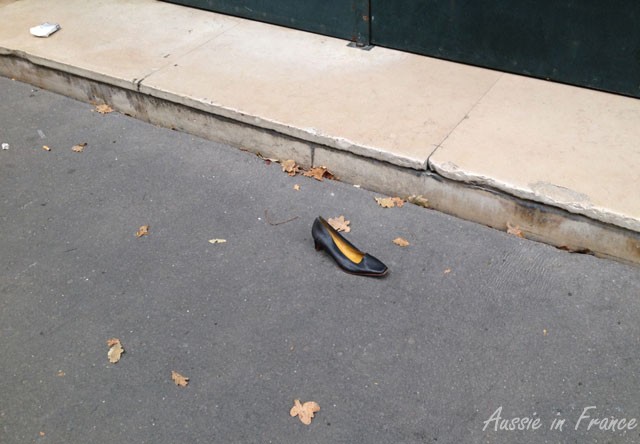
Jean Michel turns up with the car and we bundle it all in. I take everything to La Ressourcerie at 62 rue Oberkampf because there’s no way we can store any of it. Black Cat is very pleased with her takings and I have had a most enjoyable day with my daughter!
Wednesday’s Blogger Round-up: Butte aux Cailles – Texting in French – Céléri Rémoulade
This week, Filly di Somma, writing for Guide2Paris, takes us off the beaten track to the Butte aux Cailles in Paris, while Katerina Forrester, in a post for My French Life gives us tips on text messaging in French. Meanwhile, Susan from Days on the Claise tells us about a little-known vegetable – celeriac – and how to prepare it. Enjoy!
Butte aux Cailles – A True Paris Ambiance
by Filly di Somma, a fanatical Paris fan, in one of her regular posts for Guide2Paris, which aims to be the complete source of information in English about the Ile-de-France region of France which includes the city of Paris. Designed specifically for English speakers visiting Paris or the region of Ile-de-France, contemplating buying property in Paris or those already living in Paris.
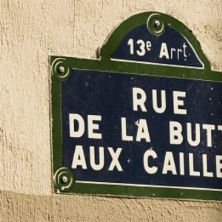 During my last trip to Paris I had the opportunity to visit a lovely ‘quartier’ which I hadn’t previously discovered on my trips to the city. “The Butte aux Cailles” district is almost like a separate village in the centre of Paris in the 13th arrondissement. Whilst being driven there by a lovely Parisian, I discovered and adored the narrow cobblestone streets featuring original restaurants, cafes and boutiques full of people eating and drinking outside. I loved its art deco architecture and its traditional Paris atmosphere.
During my last trip to Paris I had the opportunity to visit a lovely ‘quartier’ which I hadn’t previously discovered on my trips to the city. “The Butte aux Cailles” district is almost like a separate village in the centre of Paris in the 13th arrondissement. Whilst being driven there by a lovely Parisian, I discovered and adored the narrow cobblestone streets featuring original restaurants, cafes and boutiques full of people eating and drinking outside. I loved its art deco architecture and its traditional Paris atmosphere. Unlocking French language: text a’grieve’iations
by Katerina Forrester, born in Australia but always longing to be French at heart, currently living the Arts student life in Melbourne, where she is studying to become a Linguist. writing for My French Life, a global community of French and francophiles connecting like-minded people in English & French
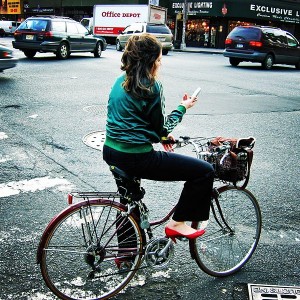 LOL is the furthest I will go when writing with text abbreviations. Nothing more, nothing less. When writing texts in English, I write in full, and I write with proper syntactic features. I don’t want to be seen as an over-texting teenager! I want my friends to receive properly articulated sentences with substance. Nevertheless, this is not the case when I text to friends in French. Read more
LOL is the furthest I will go when writing with text abbreviations. Nothing more, nothing less. When writing texts in English, I write in full, and I write with proper syntactic features. I don’t want to be seen as an over-texting teenager! I want my friends to receive properly articulated sentences with substance. Nevertheless, this is not the case when I text to friends in French. Read more
Céleri Rémoulade
by Susan from Days on the Claise, an Australian living in the south of the Loire Valley, writing about restoring an old house and the area and its history and running Loire Valley Time Travel.
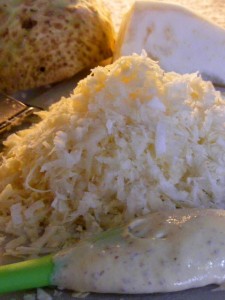 The general appearance of celeriac doesn’t inspire much confidence in it being tasty, and even less so if you consider eating it raw. Nevertheless, the most popular dish using celeriac (céleri-rave in French) does indeed use raw, grated celeriac.
The general appearance of celeriac doesn’t inspire much confidence in it being tasty, and even less so if you consider eating it raw. Nevertheless, the most popular dish using celeriac (céleri-rave in French) does indeed use raw, grated celeriac.
Don’t be fooled into thinking that this is diet food though. This is a dish to which cream is added in order to make it lighter (!!) and easier to digest (!!!) It is tremendously popular in France, but I don’t think many people bother to make it themselves. Most people buy it from their trusted local charcutière traiteur (delicatessen). If you do make it at home, it’s not just a matter of grating some celeriac and coating it with mayonnaise. There’s a trick to getting the deli style céleri rémoulade. Read more
Saint Eustache and the Fish of Remorse
You’ve probably never even heard of Saint Eustache, although you may have seen it if you’ve been to the famous market street of Montorgueil behind the old central markets or halles which are under renovation at the moment and not exactly a tourist attraction.
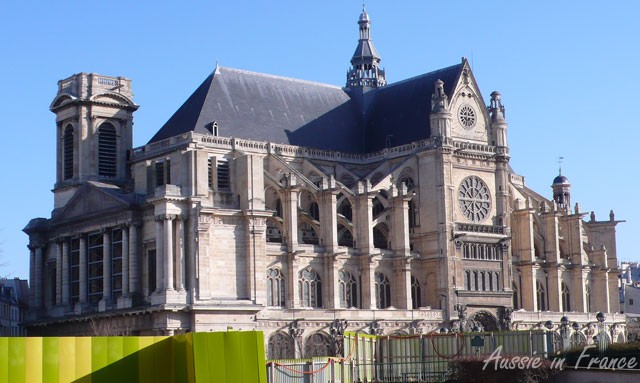
The church is very ornate, in the gothic style of Notre Dame. Like many cathedrals, it took over a hundred years to build – from 1532 to 1640 – and is located on the site of a chapel dedicated to Saint Agnès. The plan is gothic but the decoration is renaissance. Over 33 metres high, 100 metres long and 43 metres wide, it is very imposing despite its missing tower.
So how do we tell the difference between gothic and renaissance? Gothic architecture originated in France in the 12th century and its most famous example is Notre Dame. Its characteristic features are the flying buttress, the ribbed vault and the pointed arch.
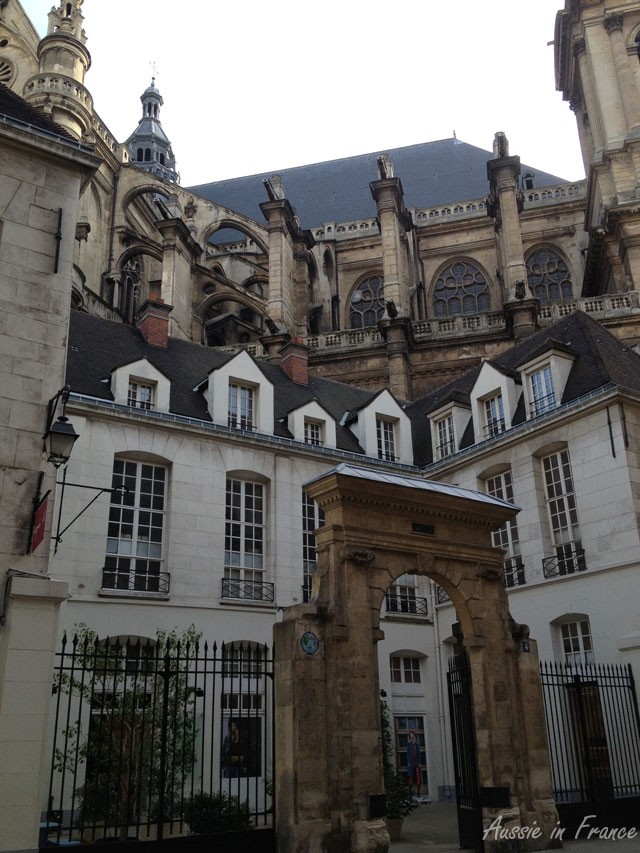
It was the flying buttress that enabled architects to build increasingly higher churches because the buttress takes the extra weight off the load-bearing walls. Churches in the previous period – Romanesque or roman in French were much smaller and had no buttresses. They are more prevalent in the south of France.
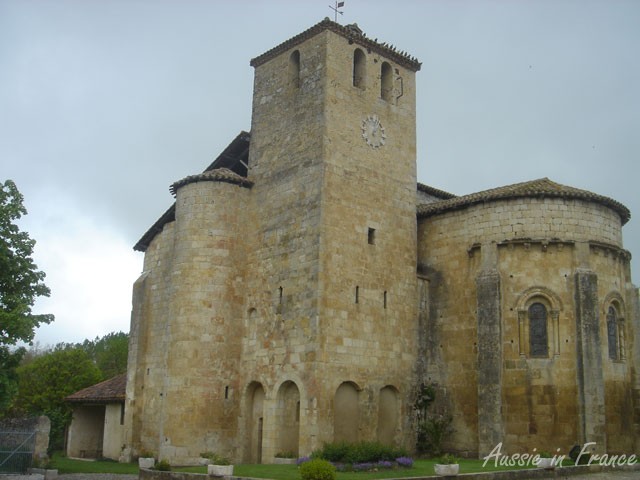
Along with the ribbed vault, the flying buttress meant that more windows could be added high up in the building. When ribbed vaulting is used, the arching and intersecting stone ribs support a vaulted ceiling surface made of thin stone panels, which greatly reduces the weight of the ceiling vault.
The pointed or ogival arch may be of Islamic origin or have evolved naturally in Western Europe as a structural solution to a purely technical problem but whatever the case, it ‘s a distinguishing feature of Gothic architecture.
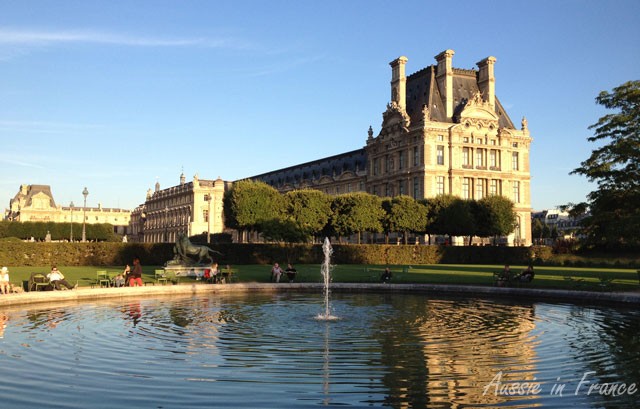
Renaissance is the next period after that, between the early 15th and early 17th centuries. It originated in Italy but soon spread across Europe. It puts emphasis on symmetry, proportion and geometry and features orderly arrangements of columns, pilaster and lintels, with semicircular arches, hemispherical domes, niches and edicules. The Louvre is a prime example of Renaissance architecture.
The buttresses on Saint Eustache are not as obvious as those of Notre Dame, for example, and the western façade, with its classical lines, is perfectly symmetrical except for the missing tower.
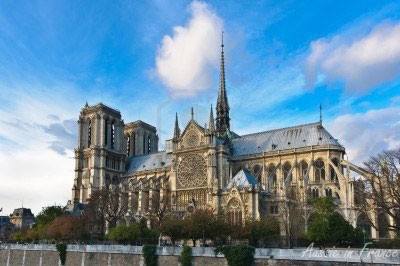
If you go around the back of Saint Eustache, you’ll see a small plaque dated 1213 with a fish trying to bite its tail, a reminder that a man once made his fortune from the local fish markets. On Sundays, our fishmonger’s stall is coincidentally just in front of it!
Jean Allais, a Parisian bourgeois, helped to finance Philippe Auguste’s crusades and in return, he asked to be allowed to levy a tax of one denier for each basket of fish sold in the covered market (or Halle whence the current name of the area).

He made a fortune and felt such remorse ( !!!) that he built a chapel for the fishmongers dedicated to Saint Agnès. It was added to over the centuries, partly demolished, and rechristened Saint Eustache. It was finally razed to the ground in the 16th century and the present church built and never completed.
A crypt in the basement of the church still bears the name of Saint Agnès. Remains of the original chapel can still be seen. Access is via a small door, but only during temporary exhibitions and concerts.
Which is your favourite Gothic church?
Monday’s Travel Photos – Sofia off the beaten track
When visiting a new city, I’m always on the lookout for things I haven’t seen anywhere else or that catch my attention because they are unexpected. Sofia provided lots of opportunities!
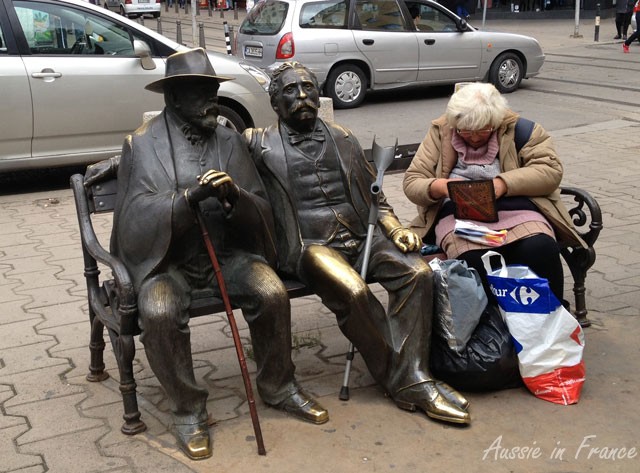
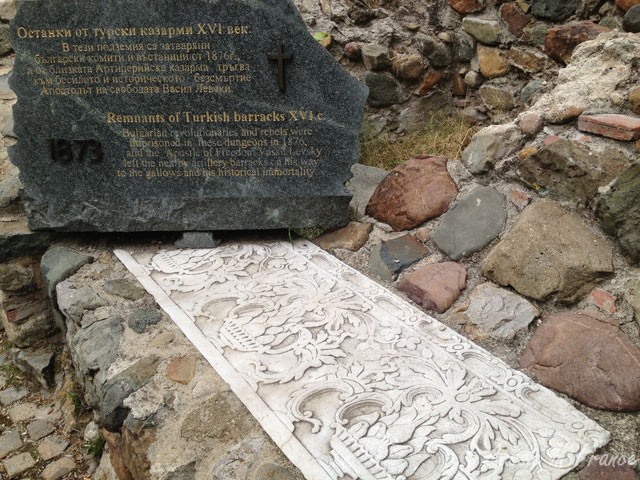
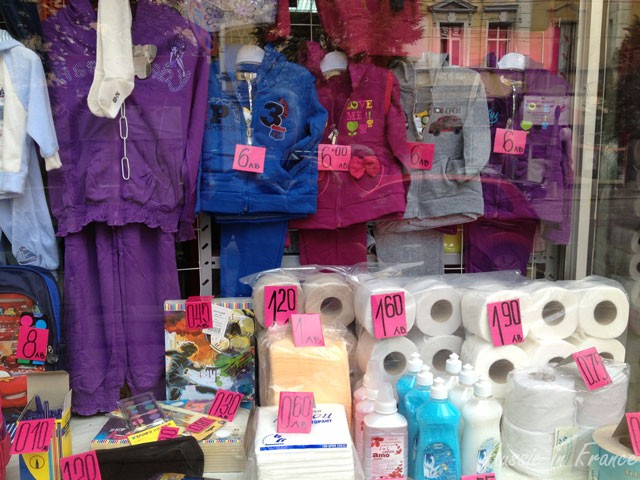
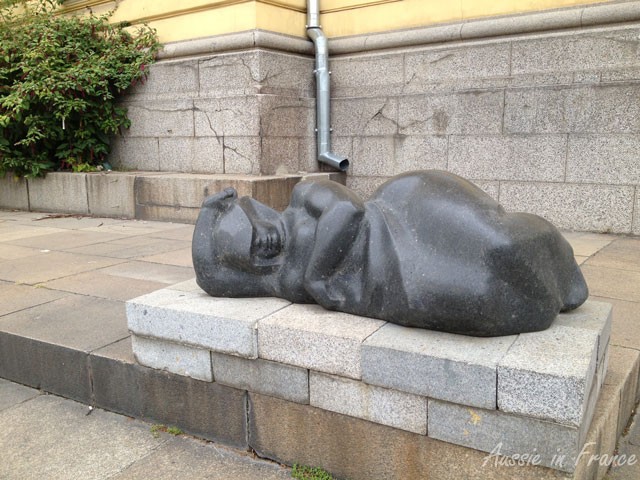
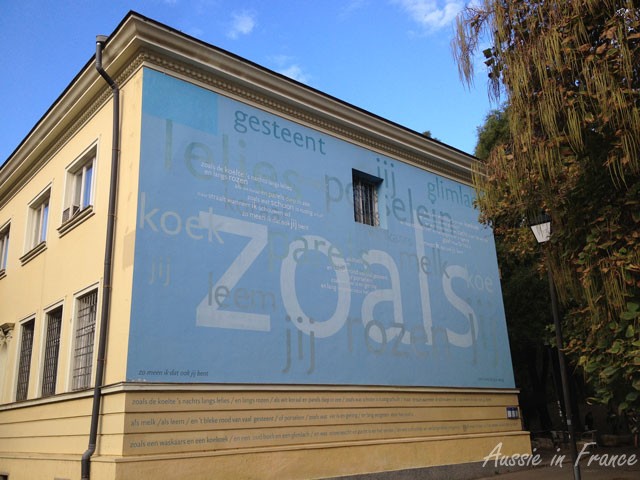
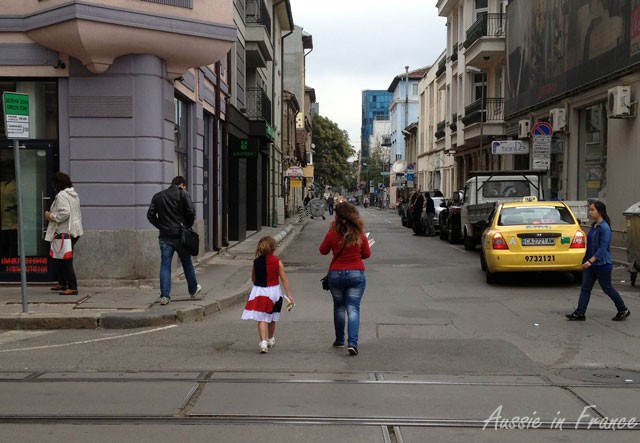
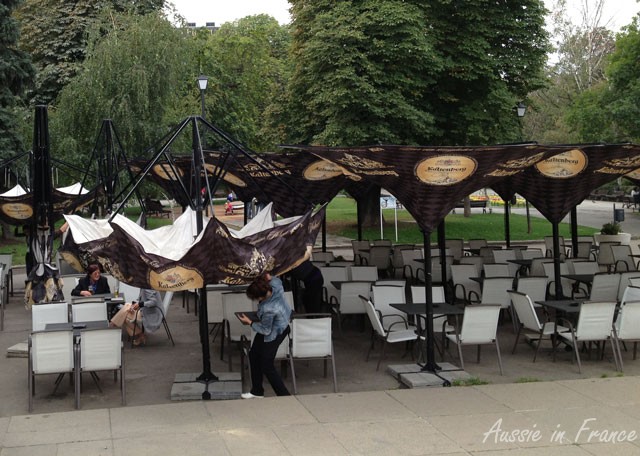
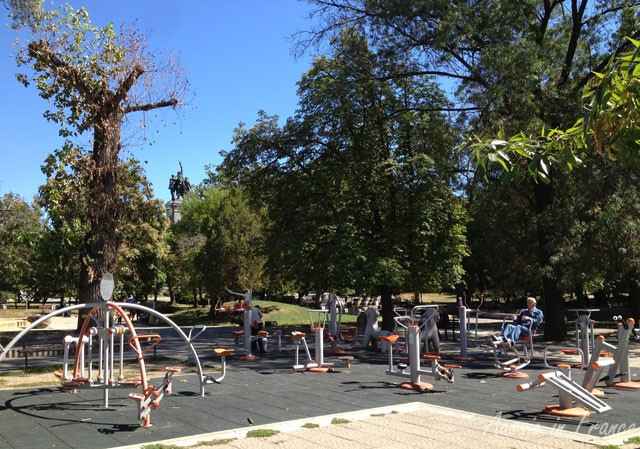
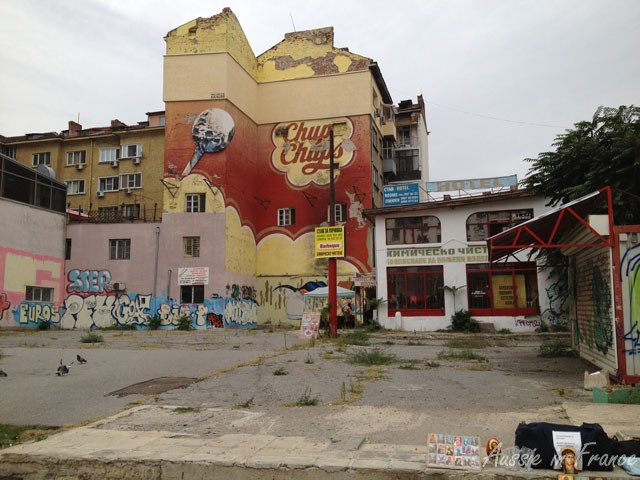
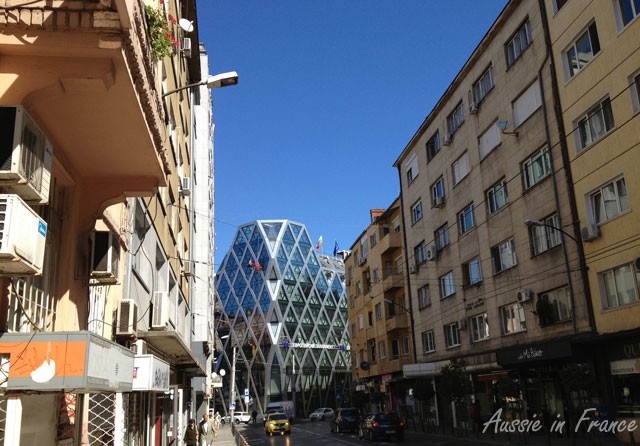
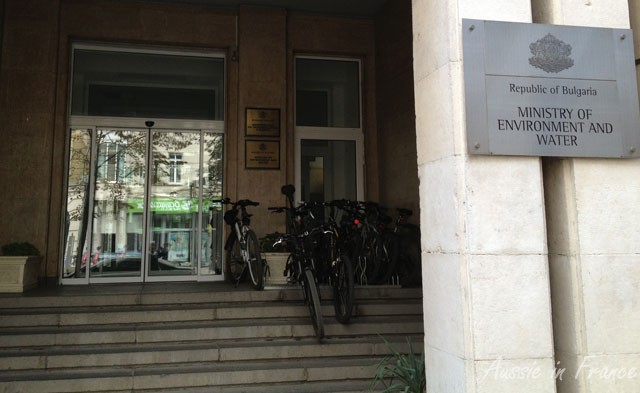
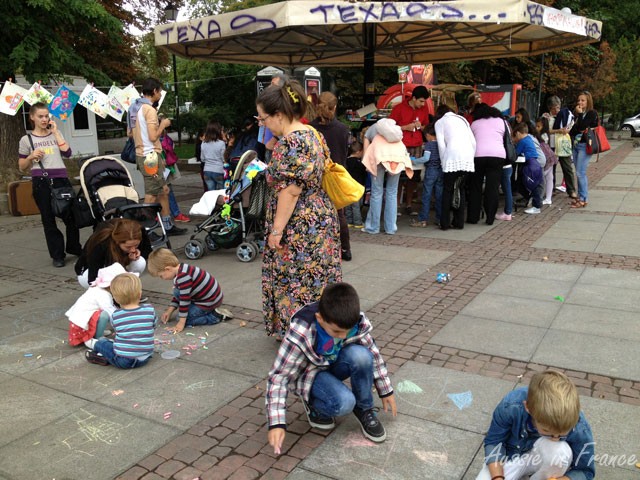
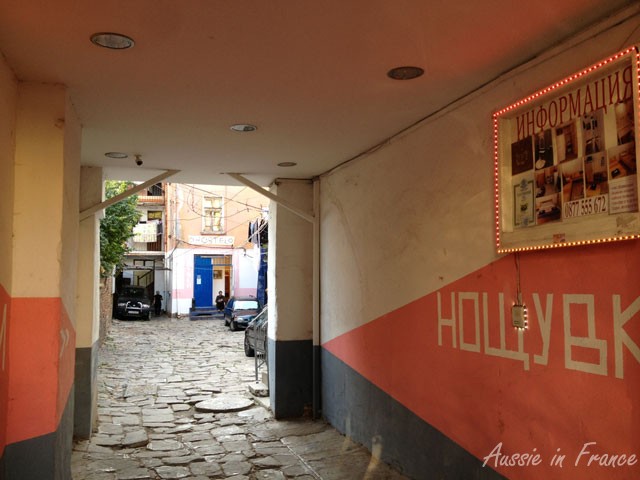
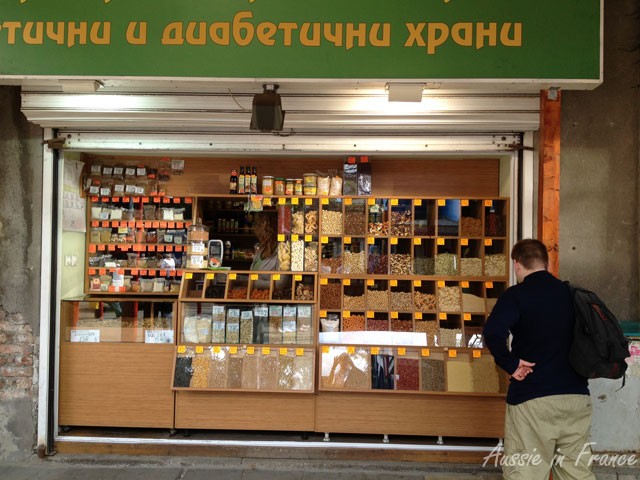

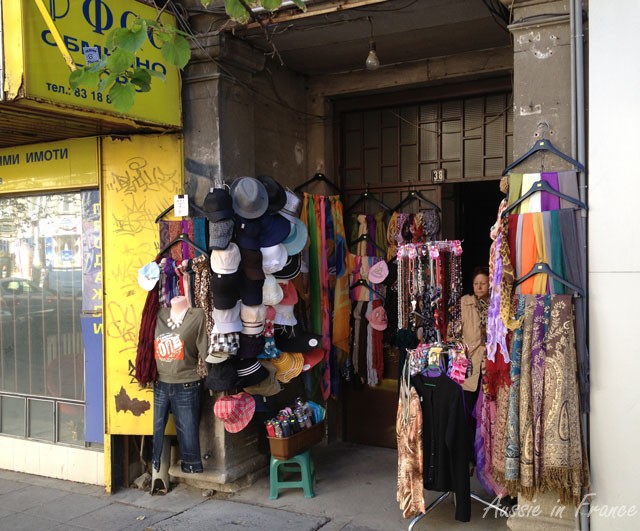
If you have enjoyed reading this, don’t forget to subscribe to new posts using the subscription form on the top right – that way you’ll get them directly on your smart phone or in your mail box! And I love to hear your comments!
Friday’s French: confondre is confusing!
Confusing is a word we use quite a bit in English to mean that something is unclear and difficult to understand. e.g. “The information he gave me is confusing.” If I confuse John and Paul, it means that I wrongly think that John is Paul and Paul is John. Now I hope I’m not confusing you too much!

Now, to say the same thing in French is a little bit complicated. The verb confondre does exist and can be used in the second example: Je confonds toujours John avec Paul. That’s easy. It can also be used without avec as in the caption above where it’s understood that you mustn’t confuse the fly agaric with any other mushrooms (not that you can – it’s very distinctive).
However, to say that “information is confusing” requires a slightly different approach. Les informations sont confuses is not quite the same meaning. [Note the plural in French and the singular in English]. In the first case, the information has not been presented correctly, while in the second, it may be the person’s lack of knowledge of the subject that prevents them from understanding. A bit confusing, huh?
Les informations ne sont pas claires is probably the most usual way of expressing the idea. You may already have noticed that French often uses a negative when a positive would be used in English.
So how are we going to translate “a bit confusing”? I would tend to say difficile à comprendre or pas vraiment clair but you might have some other ideas.
Now if you say to someone, je suis confuse, it doesn’t mean you are confused at all, but that you are embarrassed about something you’ve said or done! It’s actually a veiled apology.
How about “You’re only confusing the issue”? Vous compliquez tout! Vous ne faites qu’embrouiller les choses. In fact embrouiller which means obscurcir, compliquer une question, une affaire, y mettre la confusion often conveys the same meaning as the English verb confuse. Tu ne fais que m’embrouiller: you’re confusing me. Il s’embrouille: he gets muddled, he gets confused. We could say les informations sont embrouillées to mean that the information is not presented clearly.
Now it’s over to you. Let’s have some suggestions on how to translate the following sentences:
1) Are you still confused about how to use confuse in French?
2) I was confused when nothing happened.
3) Imminent and eminent are easily confused words.
Are there any other examples of confuse that you don’t know how to say in French?
If you have enjoyed reading this, don’t forget to subscribe to new posts using the subscription form on the top right – that way you’ll get them directly on your smart phone or in your mail box! And I love to hear your comments!
Fabulous Rila Monastery and Boyana Church in Bulgaria
We’re debating about a day trip from Sofia to Rila Monastery because it’s a 2 to 2 ½ hour bus trip each way (120 K) but various friends have encouraged us to go and the photos are certainly encouraging. It’s also a World Heritage site. We also want to go to Boyana Church in the suburbs of Sofia. After a search on the Internet I find a company called Traventuria offering a day trip including both destinations for 25 euro per person, which is an attractive price. I check out Trip Advisor and the fact that the coach drivers are reputed to be careful cinches it for me.
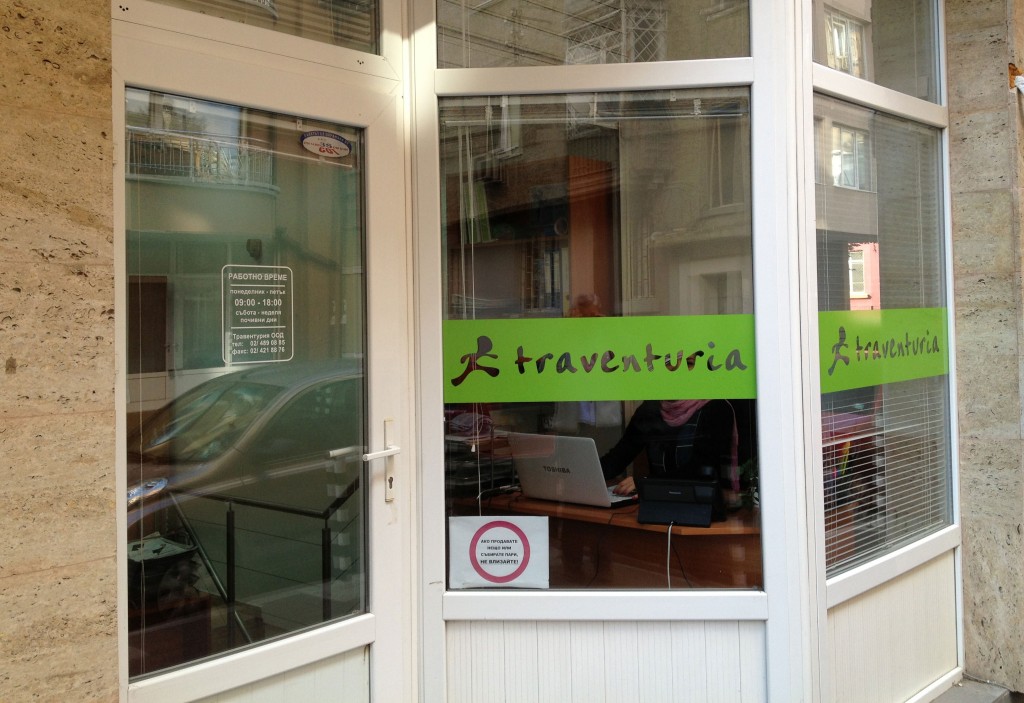
As I start booking, I notice the address at the bottom of the screen. Unbelievably, it’s the same address as ours – their office is on the ground floor of our home exchange building in Veslets Street. We decide to go and pay in cash next morning. The girl is very friendly, speaks excellent English and even gives us an aluminium water bottle each.
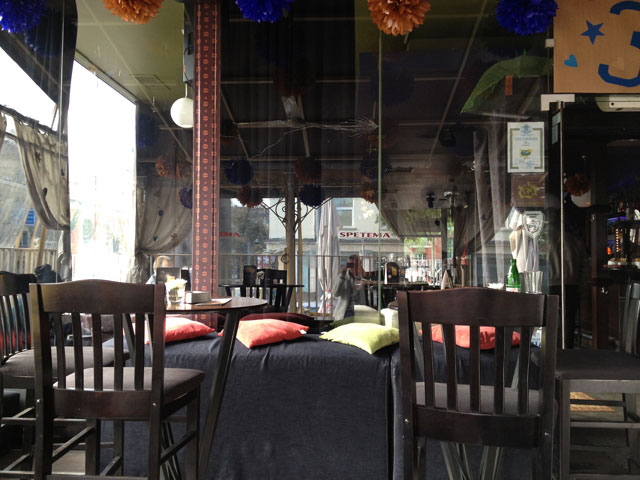
We set off at 8.15 to be well in time for our 9 am rendez-vous behind Nevski Cathedral. Sofia is quite different at that hour, we discover, with everyone hurrying to work. We have time for a coffee at a trendy bar called Spetema just opposite the university.
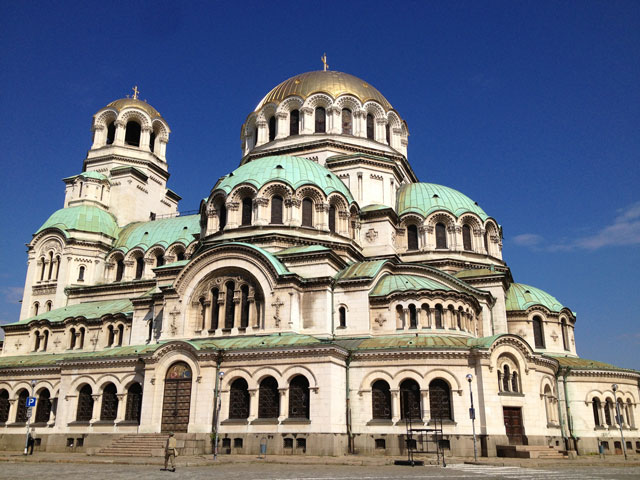
Our 12-seater mini-bus pulls up on time but we wait for a couple of people who never come and finally move off at 9.15 am. There are eight of us altogether. Our young guide tells us the programme: a two-hour drive with a ten-minute rest-stop on the way, two hours at Rila, then back towards Sofia and Boyana where we stop for half an hour. We’ll be back in Sofia by 5 pm.
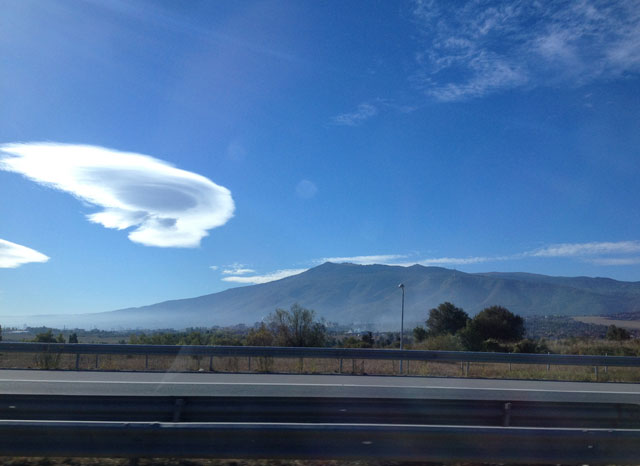
We’re soon on a recent 4-lane highway going at a reasonable pace. I’m reassured. The countryside looks surprisingly like Australia, minus the gum trees. There is little agriculture and only a few weedy looking cows. The cloud formation is quite unique. Jean Michel says there must be a lot of wind. The sky is a deep blue.
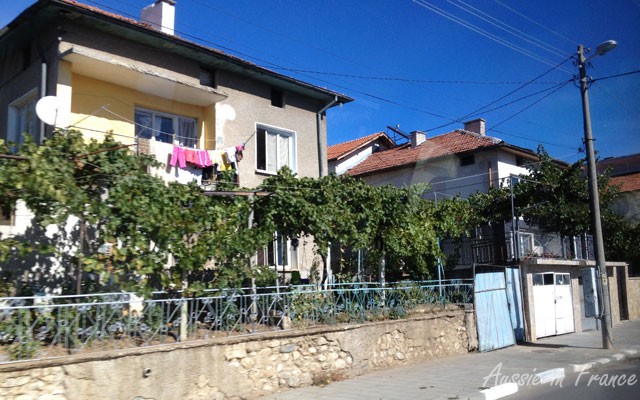
After our rest-stop, we soon turn left and begin circumnavigating Rila Mountain, before making the ascent. I’m amazed at how many houses in the villages have grape vines. The monastery is 1147 metres above ground level (the highest peak on Rila is 2925 metres). We go through mountain forest most of the time. The driver is going quite slowly and I’m not afraid.
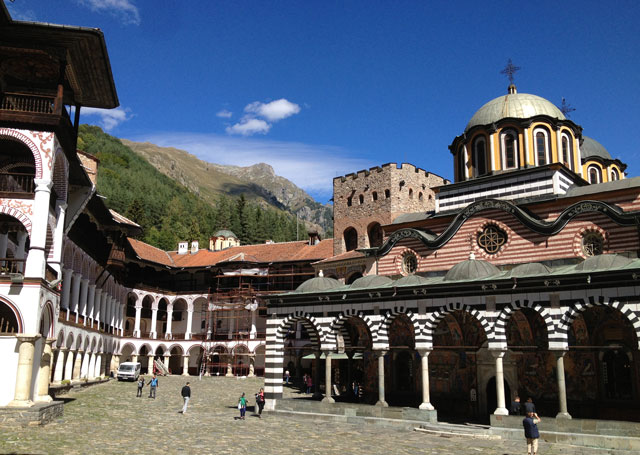
At the top, he pulls up and we get out. The initial impression is quite fabulous and we are not disappointed with the rest of our visit. We expected more people, but are pleasantly surprised to see that if we wait long enough, we can take photos without tourists in brightly coloured clothing taking photos of each other.
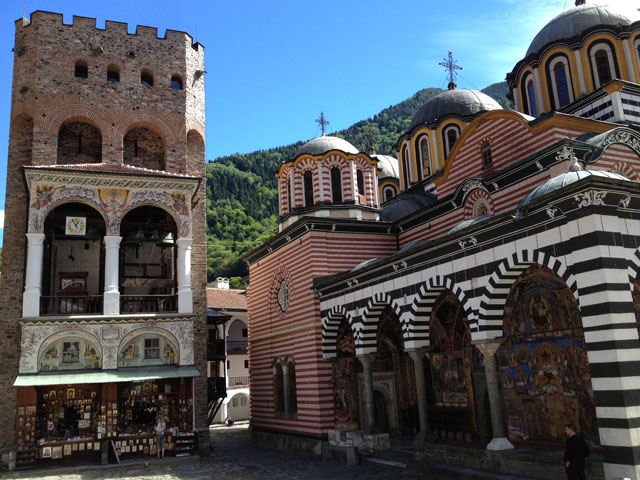
Jean Michel finds a booklet in French and we track down all the things to see because it’s a bit tedious to translate my audio-guide. Rila was founded in the 10th century by the hermit St John of Rila. It was destroyed by fire in the 19th century and rebuilt between 1834 and 1862 and is a characteristic example of the Bulgarian Renaissance (18th-19th centuries), symbolising the awareness of a Slavic cultural identity following centuries of occupation.
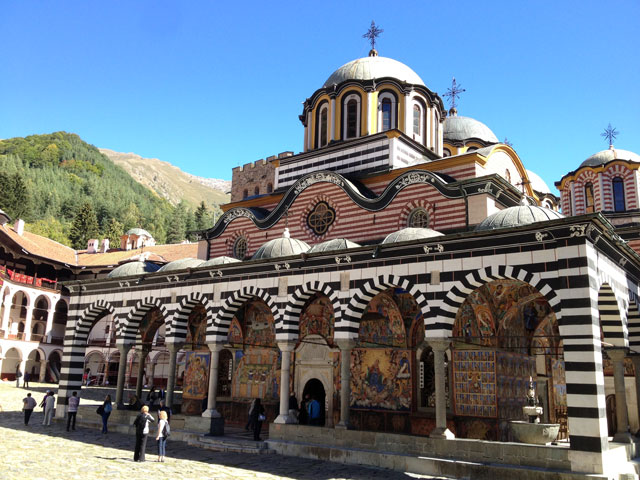
At the end of our visit, there are still three things on the list we haven’t seen, one in the koprivchtitsa room, one in the priory and the other in the tower chapel. We ask in the religious shop and are told to inquire at the museum which we have already visited and contains the most fabulous carved cross I’ve ever seen (81 x 43 cm) by a monk called Rafail, with 104 religious scenes and 650 miniature figures and 12 years in the making. Hardly surprising that Rafail lost his sight in the process. No photographs allowed however.
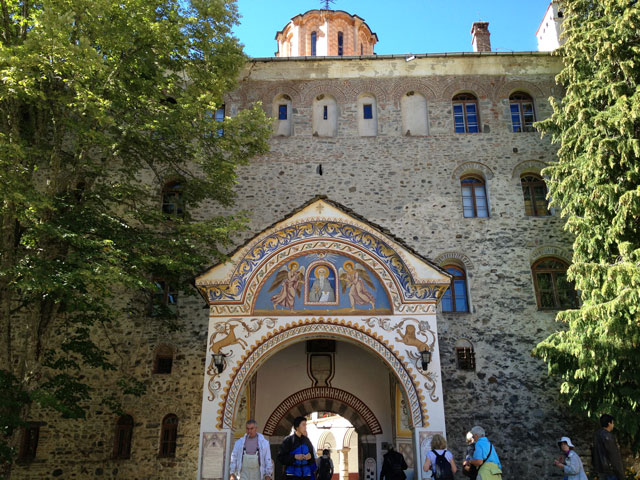
First, we are told no, then the lady at the cash desk picks up her phone, puts it down again and says “30 minutes”. By that time our mini-bus will have left. Disappointed we didn’t ask earlier, we go and wait for our bus which soon appears.
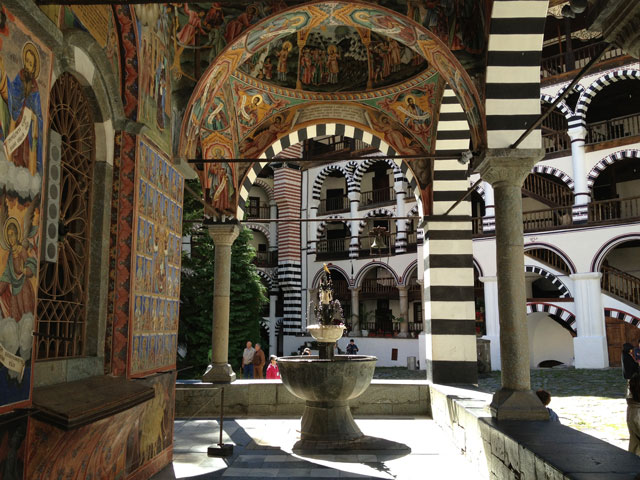
One and a half hours later, our guide tells us we are nearing Boyana Church and that two large coach-loads are expected. If we want to get in before them (only 12 people are allowed in the church at a time for a maximum of 15 minutes), we have to hurry. He collects our entrance fee (10 lev per person) and when we arrive, he buys our tickets and takes us down to the little church.
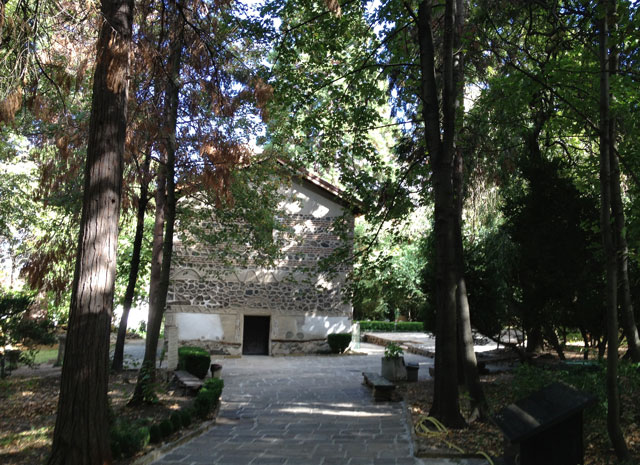
There are three churches, each joining onto the other, built in the 10th to 11th, 13th and early 19th centuries. The frescoes are all from the 14th century. To quote a UNESCO review of this World Heritage site, those painted in 1259 “possess a rare freedom, realism, harmony in the proportions, liveliness and warmth that already foresaw the birth of the Italian Renaissance. The site is one of the most complete and perfectly preserved monuments of east European mediaeval art.”
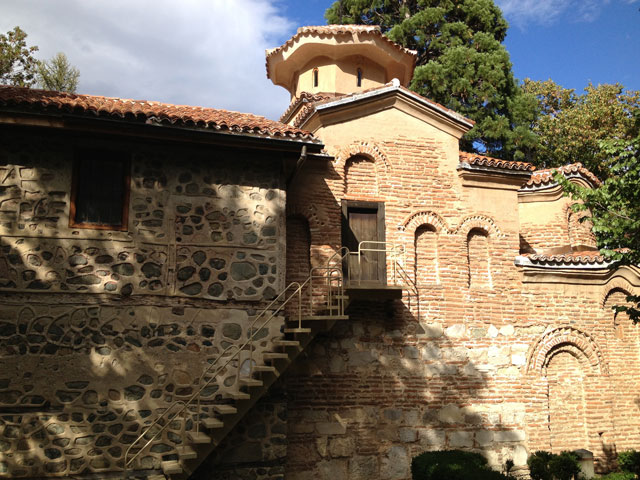
The faces are extremely expressive and the figures include Sebastocrator Kaloyan and his wife Desislava who commissioned the 13th century extension and the frescoes. Our party didn’t choose a guided visit, but I definitely recommend you to do so. As usual, photos of the interior were not allowed, but the website Pravoslavieto has excellent illustrations and descriptions.
This is definitely our best day in Bulgaria so far.
Traventuria Ltd., 45 Veslets Str., 1202 Sofia, BULGARIA, 0035924890884 (Monday – Friday, 08:30 – 16:30 CET), Fax: 0035924917352, www.traventuria.com, info@traventuria.com If you have enjoyed reading this, don’t forget to subscribe to new posts using the subscription form on the top right – that way you’ll get them directly on your smart phone or in your mail box! And I love to hear your comments!Romania’s Outrageous Palace of the Parliament – Paris Fashion Week SS 14 – Charles de Gaulle airport to city centre
Wednesday’s Bloggers Round-up time again. After visiting Budapest and Sofia and reading Andrea’s post on Bucharest in Rear View Mirror, I’m ready to add Romania to my travel destinations. As you know, I’m not a fashionista, but fortunately, other bloggers are covering Paris Fashion Week. I’m referring you to Sylvia’s first post on the subject in Finding Noon but don’t stop there – check out her other more recent posts. And so that you won’t stop using the train to go from Charles de Gaulle airport to the city centre just because we nearly had a backpack stolen, here’s a comparison of travelling methods by Jill from Gigi’s French Window. Enjoy!
Romania’s Outrageous Palace of the Parliament
by Andrea from Rear View Mirror (formerly Destination Europe), a fellow Australian who, after 6 years of living in France, has given up herParis apartment to live a nomadic life slowing travelling around Europe, experiencing each destination like a local.
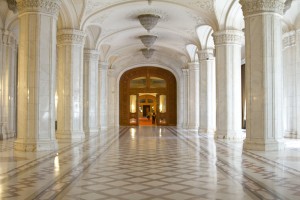 Upon setting eyes on Bucharest’s Palace of the Parliament, I was slightly underwhelmed. Yes, it’s a massive building but it didn’t strike me as being particularly remarkable or memorable. It didn’t have that grandiose feeling I had experience when seeing photos in the past. But when entering the first of countless marble filled halls I realised just how extravagant this 370,000 sq.m. building really is. Read more
Upon setting eyes on Bucharest’s Palace of the Parliament, I was slightly underwhelmed. Yes, it’s a massive building but it didn’t strike me as being particularly remarkable or memorable. It didn’t have that grandiose feeling I had experience when seeing photos in the past. But when entering the first of countless marble filled halls I realised just how extravagant this 370,000 sq.m. building really is. Read more
Paris Fashion Week SS 14
by Sylvia from Finding Noon, an American living in Paris who appreciates fine art, good music, succulent food, and breath taking scenery
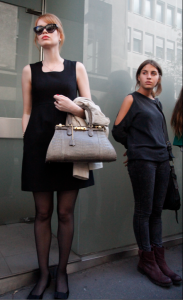 SS 14 is fashion speak for Spring/Summer 2014, and this being fall 2013, its that time of year again… Fashion Week. I’ve got Le Gastro, which is a charming local way of saying a tummy bug, so it wasn’t sure that I was going to be able to drag myself out into the glorious Paris sunshine and start shooting, but I had worked so hard getting the fashion show invites and I really do love seeing all those creative types out there doing their thing, I simply could not stay put. So while all the other girls were out there sporting their ‘it’ bags, I was sporting the bags under my eyes and taking as many clichés as I could get away with. Here is what I saw yesterday: Read more
SS 14 is fashion speak for Spring/Summer 2014, and this being fall 2013, its that time of year again… Fashion Week. I’ve got Le Gastro, which is a charming local way of saying a tummy bug, so it wasn’t sure that I was going to be able to drag myself out into the glorious Paris sunshine and start shooting, but I had worked so hard getting the fashion show invites and I really do love seeing all those creative types out there doing their thing, I simply could not stay put. So while all the other girls were out there sporting their ‘it’ bags, I was sporting the bags under my eyes and taking as many clichés as I could get away with. Here is what I saw yesterday: Read more
Charles de Gaulle airport to city centre
by Jill from Gigi’s French Window, French ponderings from an Australian who must have been French in another life
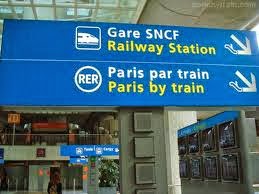 The first couple of days on arrival in Paris are always a mixed bag….EXHAUSTION being the first thing that comes to mind!
The first couple of days on arrival in Paris are always a mixed bag….EXHAUSTION being the first thing that comes to mind!
But then there is also that feeling on stepping from the flight into Charles de Gaulle airport… for me, it’s a wonderful sensory overload……
I close my eyes and breathe in deeply…..there is nowhere else I could be….this is Paris! There is a certain something in the air and I love it! Below is a Charles de Gaulle airport promo video you may enjoy…must admit they paint a very ‘friendly’ picture…….;) Read more
If you have enjoyed reading this, don’t forget to subscribe to new posts using the subscription form on the top right – that way you’ll get them directly on your smart phone or in your mail box! And I love to hear your comments!
Pickpockets on the train from Charles de Gaulle Airport
We’re on our way back from Sofia. A couple of people asked us whether we had any safety issues in Bulgaria but we didn’t. Apart from an insistent beggar in Plovdiv, we always felt perfectly safe, even walking through deserted streets at night (except for the pavements which are treacherous).

We have a large suitcase, a smaller roll-on bag, a backpack and a handbag (which I don’t usually carry when I travel but it’s easier than putting it in my roll-on). We’re sitting in the RER train that goes from Charles de Gaulle Airport to Châtelet-les-Halles in the city centre. We are sitting in the aisle opposite each other. I have the handbag on my lap with my hands on it. My iPhone is in the zipper closest to my lap because I’ve had that stolen before. The suitcase is on the floor near the window with the roll-on on top of it. The backpack is on the seat next to Jean Michel. His wallet, etc. are in his shirt flap-pocket. My wallet is in my bag.
Jean Michel then does something stupid (his admission). As we’re nearly home, he removes a little purse from the backpack and takes out his keys. He puts the now empty purse back into the backpack.
The train stops and a young man drops some coins on the floor next to us. While the door is still open, he bends down to pick them up. He indicates that one has gone under Jean Michel’s seat. Instinctively clutching my handbag (at least I’ve acquired that reflex at last!), I’m looking for the coin.
Suddenly, I see Jean Michel’s hand reach out to clutch another man’s sleeve next to us and then see his backpack on the floor. Both of the men dash out of the train just as the door closes.
Somewhat shaken, I ask Jean Michel what happened. The second man came from behind him and plucked the backpack from the seat. He then made the error (for him, not us!) of trying to leave the train from the door in front of Jean Michel. Had he left from the door behind, in the next wagon, he would have got away with it. Jean Michel immediately realised what was happening and grabbed his sleeve. The man was forced to let go and run for the door.
These are not organised professionals, in our opinion, just petty thieves used to working together whence the exit mistake.
The carriage is buzzing. Everyone is astounded but, you may be sure, not one of them would have tried to stop the thieves.
The moral is this: watch your belongings at all times. Make sure you don’t have too many bits of luggage. You can use a ribbon or shoelace or something to tie your luggage together until it’s time to get out the train. Don’t be silly enough to remove a purse from your backpack or bag in public transport.
AND DON’T BE FOOLED BY PEOPLE DROPPING COINS ON THE FLOOR!!!
N.B. Do read the comments to this post – there are other scams to be aware of too.
If you have enjoyed reading this, don’t forget to subscribe to new posts using the subscription form on the top right – that way you’ll get them directly on your smart phone or in your mail box! And I love to hear your comments!

